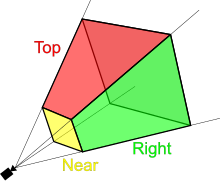In 3D graphics

In three-dimensional graphics, the terminology of clipping can be used to describe many related features. Typically, "clipping" refers to operations in the plane that work with rectangular shapes, and "culling" refers to more general methods to selectively process scene model elements. This terminology is not rigid, and exact usage varies among many sources.
Scene model elements include geometric primitives: points or vertices; line segments or edges; polygons or faces; and more abstract model objects such as curves, splines, surfaces, and even text. In complicated scene models, individual elements may be selectively disabled (clipped) for reasons including visibility within the viewport (frustum culling); orientation (backface culling), obscuration by other scene or model elements (occlusion culling, depth- or "z" clipping). Sophisticated algorithms exist to efficiently detect and perform such clipping. Many optimized clipping methods rely on specific hardware acceleration logic provided by a graphics processing unit (GPU).
The concept of clipping can be extended to higher dimensionality using methods of abstract algebraic geometry.
Near clipping
Beyond projection of vertices & 2D clipping, near clipping is required to correctly rasterise 3D primitives; this is because vertices may have been projected behind the eye. Near clipping ensures that all the vertices used have valid 2D coordinates. Together with far-clipping it also helps prevent overflow of depth-buffer values. Some early texture mapping hardware (using forward texture mapping) in video games suffered from complications associated with near clipping and UV coordinates.
Occlusion clipping (Z- or depth clipping)
|
Main articles: depth buffer and occlusion culling |
In 3D computer graphics, "Z" often refers to the depth axis in the system of coordinates centered at the viewport origin: "Z" is used interchangeably with "depth", and conceptually corresponds to the distance "into the virtual screen." In this coordinate system, "X" and "Y" therefore refer to a conventional cartesian coordinate system laid out on the user's screen or viewport. This viewport is defined by the geometry of the viewing frustum, and parameterizes the field of view.
Z-clipping, or depth clipping, refers to techniques that selectively render certain scene objects based on their depth relative to the screen. Most graphics toolkits allow the programmer to specify a "near" and "far" clip depth, and only portions of objects between those two planes are displayed. A creative application programmer can use this method to render visualizations of the interior of a 3D object in the scene. For example, a medical imaging application could use this technique to render the organs inside a human body. A video game programmer can use clipping information to accelerate game logic.[3] For example, a tall wall or building that occludes other game entities can save GPU time that would otherwise be spent transforming and texturing items in the rear areas of the scene; and a tightly integrated software program can use this same information to save CPU time by optimizing out game logic for objects that aren't seen by the player.[3]